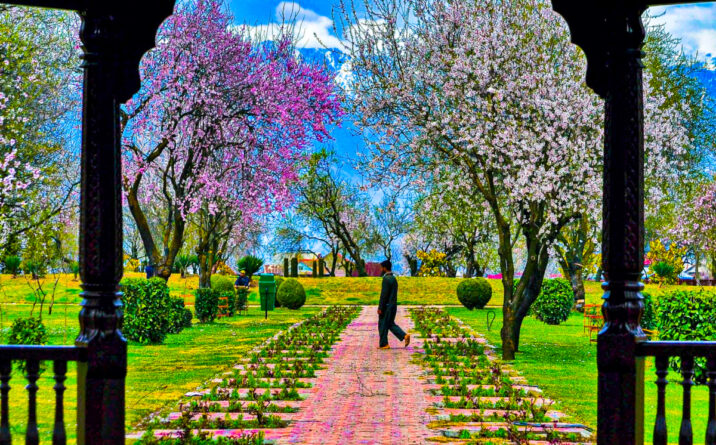
Badamwari Garden: Where Spring Paints Kashmir in Pink and White
By: Javid Amin
Srinagar 20 March 2025: As winter’s icy grip loosens over the Kashmir Valley, a delicate transformation unfolds in Srinagar. The historic Badamwari Garden, a 300-kanal (37.5-acre) sanctuary nestled at the foothills of Koh-e-Maran, erupts into a symphony of pink and white almond blossoms. This annual spectacle, a centuries-old herald of spring, draws travelers, poets, and photographers into its fragrant embrace. In 2024, the blooms arrived earlier than usual, creating a surreal contrast between snow-dusted peaks and the garden’s pastel canopy. Let’s wander through this almond paradise and uncover why it’s Kashmir’s best-kept spring secret.
01: A Walk Through Time – The History of Badamwari Garden
From Royal Orchards to Public Eden
Badamwari’s roots stretch back to the 15th century, when Sultan Zain-ul-Abidin, the “Architect of Kashmir,” planted almond groves to celebrate spring’s arrival. For generations, these blossoms symbolized renewal, inspiring Persian poets and Mughal emperors alike. However, neglect in the 20th century left the garden barren until 2008, when a major restoration revived its terraced slopes, cascading water channels, and over 1,200 almond trees.
Did You Know?
- The garden’s name combines Badam (almond) and Wari (grove) in Kashmiri.
- Locals believe the blossoms’ early bloom predicts a prosperous harvest season.
Also Read | Kashmir’s Tulip Festival: 6 Captivating Experiences to Embrace Paradise on Earth
02: The Almond Blossom Spectacle – Nature’s Grand Festival
A Kaleidoscope of Colors and Fragrances
From late February to mid-April, Badamwari becomes a living canvas. The Prunus dulcis trees – some over 80 years old – burst into clusters of pink-tipped white flowers. Interspersed with tulips, daffodils, and irises, the garden offers a sensory feast:
- Visual Poetry: Morning light filters through petals, casting a rosy glow.
- Aroma Therapy: The air carries a sweet, honey-like fragrance.
- Wildlife Harmony: Bees and Himalayan bulbuls dart among blooms.
Pro Tip: Visit at dawn for misty, crowd-free photography.
03: Beyond the Blossoms – Cultural Beats of Badamwari
Spring Festivals and Local Traditions
Badamwari isn’t just a garden—it’s a cultural stage. The annual Sounthul festival (March 15–25) features:
- Rouf Dancers: Women in pherans (traditional cloaks) perform rhythmic folk dances.
- Wazwan Feasts: Savor almond-based dishes like Badam Rogan Josh.
- Poetry Recitals: Kashmiri verses celebrating spring’s arrival.
Local Insight:
“Our grandparents courted under these trees. Even today, newlyweds picnic here for blessings,” says Ali Mohammad, a 70-year-old gardener.
Also Read | Experience the Magic: Tulip Festival 2025 in Kashmir – Your Complete Travel Guide
04: Your Ultimate Travel Guide to Badamwari
Planning the Perfect Visit
Best Time: March 1–April 10 (peak bloom varies yearly; follow @KashmirBloomTracker on Twitter).
Entry: Free; open 8 AM–6 PM.
Nearby Attractions:
- Shalimar Bagh (4 km): Mughal-era terraced gardens.
- Dal Lake (3 km): Shikara rides through floating flower markets.
Stay Here:
- Luxury: The Lalit Grand Palace (heritage suites from ₹18,000/night).
- Budget: Houseboat Zahra (double rooms ₹3,500/night with lake views).
Eat This:
- Nadru Monje (lotus stem fritters) at Ahdoos Restaurant.
05: Through the Lens – Photography Tips from Pros
Capturing Badamwari’s Ethereal Beauty
- Golden Hour Magic: 5:30–6:30 PM for warm backlighting.
- Top Angles:
- Low-angle shots with blossoms framing Hari Parbat Fort.
- Drone panoramas showcasing the garden’s terraced design.
- Gear Advice: Polarizing filter to enhance cloud contrast.
“Badamwari’s beauty is fleeting. Shoot like each frame is your last.” – Arjun Nair, National Geographic Photographer
Also Read | Pre-Wedding Shoots to Honeymoon Bliss: Kashmir Has It All
06: Sustainable Tourism – Preserving Kashmir’s Floral Heritage
Visitors’ Pledge for a Greener Future
With footfall exceeding 50,000 in 2023, conservation is critical:
- Do’s: Stick to marked paths, carry reusable water bottles.
- Don’ts: Pluck flowers; feed wildlife.
Initiative Spotlight:
The Badamwari Bloom Brigade – volunteers planting 500 new trees annually. Tourists can sponsor a sapling (₹1,200) and receive progress photos.
07: Voices from the Garden – Traveler Tales
Stories That Capture the Soul of Badamwari
- Honeymooners from Kerala: “We slow-danced under falling petals—it felt like a Bollywood movie!” – Priya & Raj.
- Solo Backpacker from Germany: “I sketched for hours; the garden healed parts of me I didn’t know were broken.” – Lena.
Also Read | Kashmir’s Iconic Tulip Garden Gears Up for Record-Breaking Visitor Footfall in 2025
Epilogue: Why Badamwari is More Than a ‘Tourist Spot’
In a world rushing toward digital escapes, Badamwari remains a testament to nature’s quiet power. Each blossom whispers tales of resilience—of a garden reborn, a valley that chooses beauty despite strife. As the petals fall, they leave behind a promise: Return next spring, and I’ll tell you new stories.
Final Tip: Pair your visit with the Tulip Festival (April 1–30) at Indira Gandhi Memorial Garden for a full floral immersion.